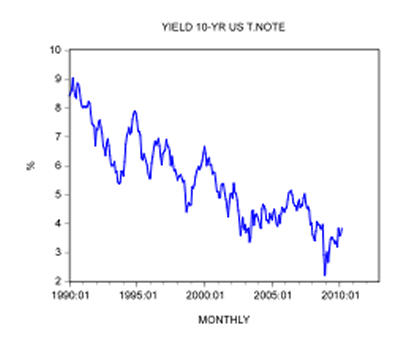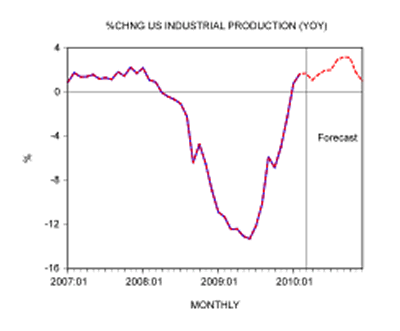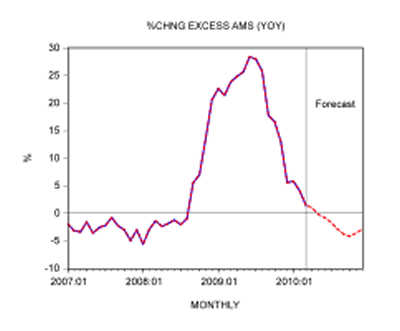What Next for U.S. Treasury Bonds?
Interest-Rates / US Bonds May 03, 2010 - 07:11 AM GMTBy: Frank_Shostak
 At the end of March the yield on the ten-year T-note closed at 3.833%, up from 3.617% the month before. Note that at the end of March last year the yield stood at 2.67%.
At the end of March the yield on the ten-year T-note closed at 3.833%, up from 3.617% the month before. Note that at the end of March last year the yield stood at 2.67%.
 To assess where yields are heading, one needs to identify the key factors that drive interest rates. Following the writings of great economic masters such as Carl Menger and Ludwig von Mises, we suggest that the driving force of interest-rate determination is individuals' time preferences. What is this all about?
To assess where yields are heading, one needs to identify the key factors that drive interest rates. Following the writings of great economic masters such as Carl Menger and Ludwig von Mises, we suggest that the driving force of interest-rate determination is individuals' time preferences. What is this all about?

The Essence of Interest-Rate Determination
As a rule, people assign a higher valuation to present goods versus future goods. This means that present goods are valued at a premium over future goods. This stems from the fact that a lender or an investor gives up some benefits at present. Hence the essence of the phenomenon of interest is the cost that a lender or an investor endures. On this Mises wrote,
That which is abandoned is called the price paid for the attainment of the end sought. The value of the price paid is called cost. Cost is equal to the value attached to the satisfaction which one must forego in order to attain the end aimed at.[1]
According to Carl Menger,
To the extent that the maintenance of our lives depends on the satisfaction of our needs, guaranteeing the satisfaction of earlier needs must necessarily precede attention to later ones. And even where not our lives but merely our continuing well-being (above all our health) is dependent on command of a quantity of goods, the attainment of well-being in a nearer period is, as a rule, a prerequisite of well being in a later period.… All experience teaches that a present enjoyment or one in the near future usually appears more important to men than one of equal intensity at a more remote time in the future.[2]
Likewise according to Mises,
Satisfaction of a want in the nearer future is, other things being equal, preferred to that in the farther distant future. Present goods are more valuable than future goods.[3]
For instance, an individual who has just enough resources to keep himself alive is unlikely to lend or invest his paltry means. The cost of lending, or investing, to him is likely to be very high — it might even cost him his life if he were to consider lending part of his means. So under this condition he is unlikely to lend or invest even if offered a very high interest rate.
Once his wealth starts to expand, the cost of lending, or investing, starts to diminish. Allocating some of his wealth toward lending or investment is going to undermine to a lesser extent our individual's life and well-being at present. From this we can infer that anything that leads to an expansion in the real wealth of individuals gives rise to a decline in the interest rate, i.e., a lowering of the premium of present goods versus future goods. Conversely, factors that undermine real-wealth expansion lead to a higher rate of interest.
Time Preference and Supply/Demand for Money Determine Interest Rates
In the money economy, individuals' time preferences are realized through the supply and the demand for money.
The lowering of time preferences, i.e., lowering the premium of present goods versus future goods, on account of real-wealth expansion, will become manifest in a greater eagerness to lend and invest money and thus lowering of the demand for money.
This means that for a given stock of money there will be an increase in the excess supply of money.
To get rid of the excess, people start buying various assets and in the process raise assets' prices and lower their yields, all other things being equal. Hence, the increase in the pool of real wealth will be associated with a lowering in the interest-rate structure.
The converse will take place with a fall in real wealth. People will be less eager to lend and invest, thus raising their demand for money relative to the previous situation.
This, for a given money supply, reduces the excess money. Consequently, all other things being equal, this lowers the demand for assets and thus lowers their prices and raises their yields.
What will happen to interest rates as a result of an increase in money supply? An increase in the supply of money, all other things being equal, means that those individuals whose money stock has increased are now much wealthier. Hence, this sets in motion a greater willingness to invest and lend money.
The increase in lending and investment means the lowering of the demand for money by the lender and by the investor. Consequently, an increase in the supply of money coupled with a fall in the demand for money raises the excess supply of money, which in turn bids the prices of assets higher and lowers their yields.
As time goes by, the rise in price inflation starts to undermine the well-being of individuals and this leads to a general rise in time preferences.
This lowers individuals' tendency for investments and lending, i.e., raises the demand for money and works to lower the excess-money-supply rate of growth — this puts an upward pressure on interest rates.
In a market economy within the framework of a central bank, the key factor that undermines the pace of real-wealth expansion is the monetary policy of the central bank. It is loose monetary policy that undermines the stock of real wealth and the purchasing power of money.
We can thus conclude that a general increase in price inflation is a factor that sets in motion a general rise in interest rates, while a general fall in price inflation sets in motion a general fall in interest rates.
"A general increase in price inflation is a factor that sets in motion a general rise in interest rates, while a general fall in price inflation sets in motion a general fall in interest rates."
Furthermore, an increase in the growth momentum of money supply sets in motion a temporary fall in interest rates, while a fall in the growth momentum of money supply sets in motion a temporary increase in interest rates.
Note again that changes in excess money supply mirror the interaction between changes in supply/demand for money and changes in the demand for money driven by changes in peoples' time preferences.
Also observe that all the factors that we have discussed so far are the factors of demand for assets such as Treasuries.
In similarity to the prices of goods and services, the price of a Treasury bond or its yield is set by the interplay between the demand and supply.
The key factor behind the supply of Treasuries is the gap between government revenue and government outlays. The greater the gap, i.e., the deficit, the more borrowing the government is going to do.
The government, however, is not a wealth-generating entity. This means that the government can never repay the debt as such. Whenever the old debt matures, the government rolls it over.
Fall in the Growth Momentum of Excess Money Puts Pressure on US Treasuries
We have seen that changes in excess money supply reflect the interplay between the supply and demand for money. This can be summarized as
excess money growth = money growth − real economic activity growth − growth in prices of goods and services
Observe that an increase in real wealth for a given money supply leads to a fall in the rate of growth in prices. This in turn, all other things being equal, leads to an increase in excess money growth, which in turn leads to the decline in interest rates.
After climbing to 28.4% in June last year, the rate of growth of our excess AMS has fallen to 2.1% in March.
We suggest that a fall in the growth momentum of excess AMS, or liquidity, is an important factor behind a visible increase in the yield on the ten-year Treasury Note (see chart).


Prospects for the Factors of Demand for Treasuries
We suggest that the tighter quantitative stance of the Fed coupled with a sharp fall in commercial-bank lending and a likely fall in lending out of thin air is going to depress the growth momentum of our monetary measure AMS.
After climbing to 152.8% in December 2008 the yearly rate of growth of the Fed's balance sheet closed at 16.3% in March. We expect the downtrend in the growth momentum of Fed assets to stay intact this year.
Likewise we forecast that the growth momentum of commercial-bank lending will be depressed this year. (Year-on-year loans to the private sector fell by 11% in March). We forecast that the yearly rate of growth of AMS will fall from 5.8% in March to 0.3% in December this year.


We expect the yearly rate of growth of industrial production to climb to 3.2% by September before a visible deceleration is forecast to take place. We forecast the yearly rate of growth to settle at 1% by December. Note we use industrial production as a proxy for real economic activity. As a proxy for price inflation we employ here yearly changes in the consumer price index (CPI). (We are well aware of the serious shortcomings of the CPI and the industrial production data).
After closing at 2.1% in February, the yearly rate of growth of the CPI is forecast to climb to 2.4% by August before settling at 2.2% in December.
Based on our forecast for AMS, industrial production, and the CPI, the downtrend in the growth momentum of excess money supply is forecast to stay in force this year. After climbing to 28.4% in June last year, the yearly rate of growth of excess money is forecast to settle at −3% by December.


Prospects for the Factors of Supply
On account of extremely loose fiscal policy the US federal government budget deficit jumped from $455 billion in calendar year 2008 to a deficit of $1.415 trillion in 2009. We envisage that a similar deficit if not higher is likely to take place in calendar year 2010.
Note that as a percentage of nominal gross domestic product (GDP) the deficit jumped from 3.2% in 2008 to almost 10% in 2009. (Also note that during the Great Depression the US budget deficit as percentage of GDP climbed from 0.6% in 1931 to 5.4% in 1934). The federal debt outstanding increased to $12.8 trillion in March from $12.5 trillion in the previous month and $11.1 trillion in March last year. We estimate that by year-end, the federal debt is likely to settle at around $14.2 trillion.


From this we can conclude that a declining excess-money growth and ever-rising federal government debt is a recipe for rising yields on government debt.
Conclusions
After closing at 2.2% in December 2008, the yield on the ten-year US Treasury note has been following an uptrend. We suggest that a strong downtrend in the growth momentum of liquidity has been an important factor in driving the yield higher. Another factor that continues to exert an upward pressure on yields is the ever-growing US federal government debt, which stood at $12.5 trillion in March. We have estimated that by December the federal debt is likely to settle at around $14 trillion.
An ever-growing diversion of real wealth toward government nonproductive programs runs the risk of further weakening the ability of the United States to generate real wealth. This in turn increases the risk of the US government not being able to service its debt. Remember, the government is not a wealth generator — it is completely at the mercy of the wealth generators in the private sector. This, of course, means that the US government must drastically cut its expenditures to prevent a serious economic disaster.
Frank Shostak is an adjunct scholar of the Mises Institute and a frequent contributor to Mises.org. He is chief economist of M.F. Global. Send him mail. See Frank Shostak's article archives. Comment on the blog.![]()
Notes
[1] Ludwig von Mises, Human Action, Contemporary Books, 3rd revised edition p. 97.
[2] Carl Menger, Principles of Economics, New York University Press pp. 153–154.
[3] Ludwig von Mises, Human Action, 3rd revised edition, pp. 483–484.
[4] Ludwig von Mises, Human Action, p. 482.
© 2005-2022 http://www.MarketOracle.co.uk - The Market Oracle is a FREE Daily Financial Markets Analysis & Forecasting online publication.



